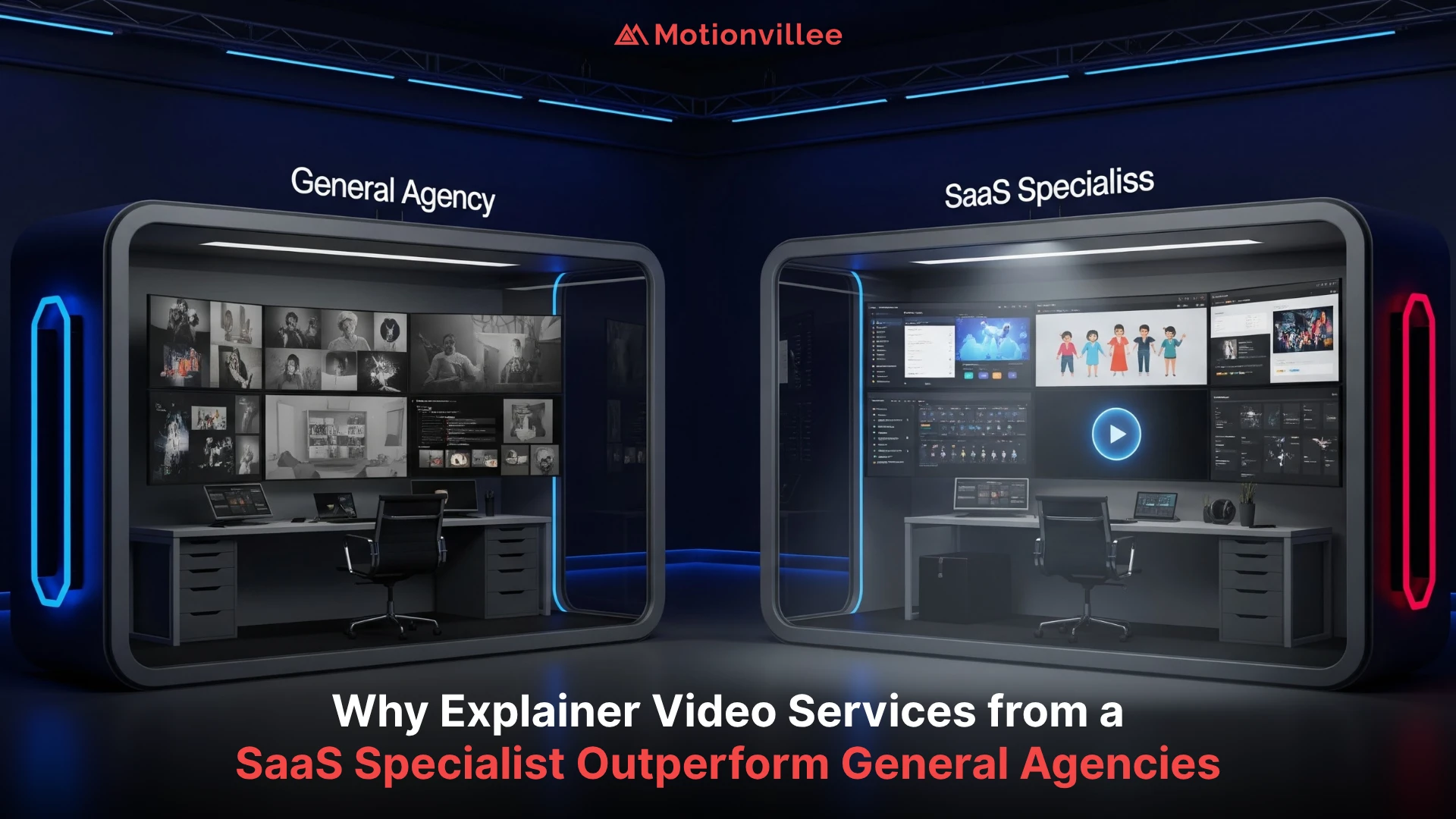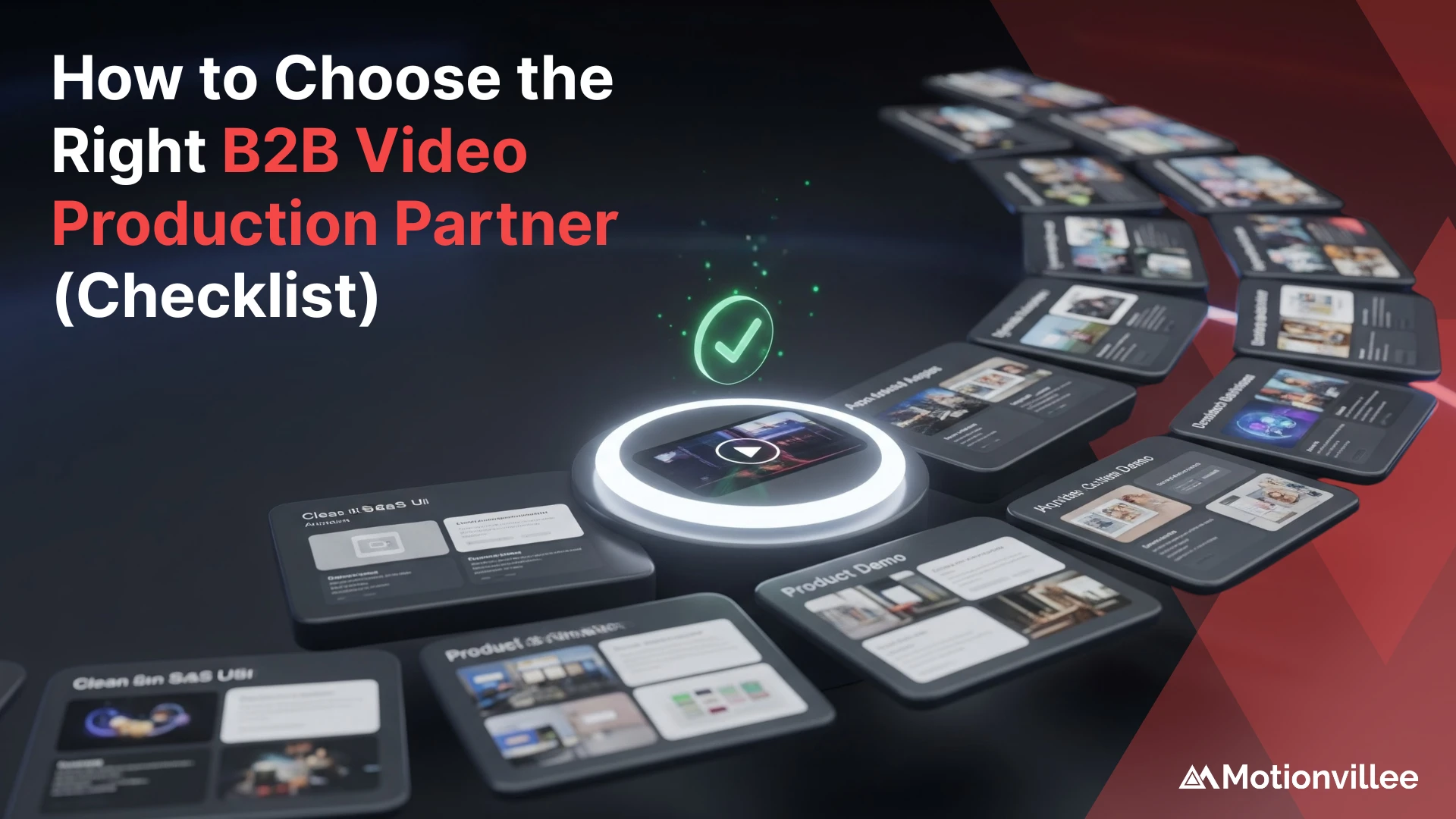Many founders make common startup video mistakes that cost time, money, and opportunities. They invest in videos expecting them to attract investors, convert customers, and build trust, only to find that the results fall short.
The problem is rarely the video format itself. It lies in how these videos are planned, structured, and distributed. A beautifully animated video without a clear strategy often fails to connect with its audience or move them to take action.
In this blog, we’ll uncover:
- The 11 biggest mistakes startups make when producing videos
- Why these mistakes prevent videos from delivering real ROI
- What the best founders do differently to ensure their videos work harder across the funnel
If you are preparing to create your next startup video, this guide will help you avoid pitfalls and produce content that truly performs.
Mistake 1: Focusing on Style, Not Strategy
One of the most common reasons startup videos fail is because they prioritize looks over purpose. Many founders believe that a flashy animation or trendy design is enough to grab attention. While visuals matter, they do not guarantee results if there is no strategic foundation.
A successful video begins with why it exists. Before production, ask yourself:
- What problem is this video solving?
- Who is the audience, and what do they need to hear?
- What action should they take after watching?
Understanding how to create a startup video that aligns with business objectives and audience needs is critical. The message, tone, and call to action should be mapped to specific goals, whether it’s attracting investors, onboarding users, or driving product signups.
When style is used to support strategy, not replace it, the video becomes both visually appealing and effective in delivering results.

Mistake 2: No Clear Message
Another reason many videos fall flat is the lack of a clear, focused message. Startups often try to include every feature, every benefit, and every detail into a single video. This leads to cluttered storytelling that confuses viewers rather than convincing them.
The biggest start-up video mistakes happen when you try to say too much at once. Viewers have limited attention spans, and if the core message is not clear in the first few seconds, they will lose interest.
To avoid this:
- Identify one primary goal for the video.
- Keep messaging simple and benefit-driven.
- Use supporting visuals to clarify, not complicate, the narrative.
Clarity always beats cleverness. A simple, well-structured message that speaks to the audience’s problem and offers a solution is far more persuasive than a beautifully designed video that leaves people wondering what you actually do.
Mistake 3: Skipping Funnel Alignment
A common oversight in startup video production is creating a one-size-fits-all video. Without aligning your video to the buyer’s journey, even great content can miss its mark. Each stage of the funnel, TOFU (top of the funnel), MOFU (middle), and BOFU (bottom), requires a different approach to messaging and style.
For example:
- TOFU: Focus on awareness. Use educational content or a startup explainer video to introduce the problem and how your solution fits.
- MOFU: Build trust. Provide product walkthroughs, customer stories, and content that helps prospects evaluate your solution.
- BOFU: Drive action. Use testimonials, ROI-focused demos, and videos with clear calls to action.
When videos do not match the viewer’s stage in the journey, they feel irrelevant and fail to move prospects forward. Founders who tailor their content for each step create a smoother path to conversion and better overall results.
The takeaway: map every video to its place in the funnel before production begins. This ensures the right message reaches the right audience at the right time.

Mistake 4: Ignoring the Audience’s Pain Points
One of the most critical start-up video mistakes is creating content that only talks about product features without addressing the viewer’s real problems. Startups often focus on what their product does, instead of why it matters to the audience. When the video fails to connect with pain points, prospects quickly lose interest.
To create videos that engage and convert, you must first understand what challenges your audience is facing. Your message should position the product as the solution to those challenges, not just a list of features.
Ways to make your video more empathetic:
- Start with the problem before introducing the solution.
- Use scenarios the audience can relate to.
- Highlight outcomes and benefits, not just specs.
Working with experts who provide explainer video services for startups can help craft narratives that focus on audience needs while subtly showcasing the product. Videos that lead with empathy resonate more, build trust, and drive stronger engagement.
Mistake 5: Weak or Missing CTA
Even well-produced videos lose impact if they fail to guide viewers on what to do next. A weak or missing call to action (CTA) is one of the easiest mistakes to make, yet it has the biggest effect on results. Without a clear next step, prospects may enjoy the video but leave without taking action.
Your CTA should be simple, direct, and aligned with the video’s goal. Instead of generic lines like “Learn more,” use CTAs that drive engagement and create urgency.
Examples of strong CTAs include:
- “Book a demo to see the product in action.”
- “Sign up now to get early access.”
- “Download the full guide to explore more solutions.”
Place the CTA naturally in the script, reinforce it visually, and repeat it at the end. When done right, the CTA gives your video purpose, guiding viewers to the next step in their journey. Without it, even the most creative video may fail to convert.

Mistake 6: Overloading with Features
A classic example of start-up video mistakes is trying to showcase every single feature in one video. Founders often believe that the more features they display, the more convincing the video will be. In reality, this approach overwhelms viewers and dilutes the core message.
Your audience does not need to see every button or setting. They want to know how the product will solve their problem and make their life easier. Instead of bombarding them with a long list of features, focus on the outcomes and value your solution delivers.
How to simplify your message:
- Pick two or three standout features and explain their impact.
- Use real-life scenarios to demonstrate benefits.
- Keep technical details for supporting materials like user guides or in-depth demos.
By prioritizing benefits over technical jargon, your video becomes clearer, more persuasive, and easier for viewers to remember. A focused message always wins over a feature-packed presentation.
Mistake 7: Poor Distribution Strategy
Even the best videos fail if no one sees them. A poor distribution strategy is one of the most overlooked factors behind underperforming startup videos. Many founders believe that simply uploading the video to YouTube or sharing it once on social media is enough to get results. Unfortunately, without a proper plan, the video reaches only a small portion of the intended audience.
Effective distribution means placing the video where your target audience spends time and ensuring they see it at the right stage of their journey. This includes:
- Embedding the video on landing pages and product pages
- Using it in email campaigns and sales follow-ups
- Running targeted ads to reach decision-makers
- Sharing it consistently across relevant social platforms
Working with startup video production experts can help create not only the video but also a clear distribution strategy to maximize its impact. When distribution is strategic, your video continues to work long after launch, driving measurable results across the funnel.

Mistake 8: Low-Quality Production for First Impressions
First impressions count, and in video marketing, production quality plays a big role in shaping how your brand is perceived. One of the critical start-up video mistakes is relying on low-quality visuals, poor audio, or inconsistent branding in the very first video a potential customer sees. These elements send the wrong signal, making your business look less professional and less trustworthy.
This does not mean every video needs a massive budget. There are times when low-production formats, like quick social updates or behind-the-scenes clips, work well to build authenticity. However, your first touchpoint—whether it is an explainer, product demo, or brand story, should feel polished and credible.
Guidelines for choosing the right quality level:
- High production: Use for brand videos, website explainers, and investor presentations.
- Casual content: Use for stories, community updates, and engagement posts after trust is built.
A well-produced video signals that you take your brand and audience seriously. It sets the tone for all interactions that follow.
Mistake 9: Forgetting Storytelling
A video without a story is easy to forget. Many startups focus on presenting facts, stats, or features, but they fail to weave them into a narrative that resonates. Viewers may watch the video, but they will not remember it or feel compelled to take action.
Storytelling is what makes your video engaging and memorable. It connects with the audience on an emotional level while guiding them through a clear structure. A good story has three essential parts:
- The problem: Show the challenge your audience faces.
- The solution: Present your product as the answer to that challenge.
- The outcome: Highlight the transformation or success they can expect.
When your video follows this flow, it feels natural and persuasive. Adding elements like relatable characters, real-world scenarios, and strong visuals amplifies the message.
Startups that use storytelling effectively make their videos stand out in a crowded market. Instead of just watching, the audience connects, remembers, and takes action.

Mistake 10: No Performance Tracking
One of the most overlooked start-up video mistakes is failing to track performance. Many startups produce a video, launch it, and then move on without measuring how it actually performs. Without data, you cannot know what is working, what needs improvement, or whether the investment is paying off.
Tracking performance gives you clear insights into audience behavior and ROI. It helps refine future videos and ensures your content strategy stays on track.
Key metrics to monitor include:
- View-through rate (VTR): Measures how much of the video is being watched.
- Click-through rate (CTR): Shows how well your call to action is performing.
- Engagement: Tracks likes, shares, and comments to gauge audience interest.
- Conversions: Determines whether viewers are taking the desired next step.
Using analytics tools like YouTube Studio, LinkedIn Campaign Manager, or Google Analytics can make this process easier. By consistently tracking metrics, you can create videos that not only look good but also deliver measurable results.
Mistake 11: Treating Video as a One-Off Asset
Another mistake startups make is treating video as a one-time project rather than part of an ongoing strategy. Producing a single video and expecting it to drive long-term growth is unrealistic. Videos work best when they are part of a series that nurtures prospects through every stage of the funnel.
A one-off approach often results in:
- Short-term visibility with no sustained impact
- Missed opportunities to educate and engage audiences over time
- Weak alignment with broader marketing and sales goals
Instead, think of video as a continuous effort. Build a library of content that supports each stage of the customer journey:
- Awareness: Use explainer videos and thought-leadership content
- Consideration: Create product demos and feature spotlights
- Decision: Share testimonials and success stories
When videos work together, they create a consistent brand presence, keep prospects engaged, and strengthen conversions. A strategy-first approach ensures your videos keep delivering value long after the first campaign ends.
What the Best Founders Do Differently
Successful founders approach video with a clear plan and purpose. Instead of focusing only on visuals, they build every video around a strategy that supports business goals and audience needs. This approach allows their videos to not only attract views but also drive meaningful action.
Here is what they do differently:
- Start with strategy: They define the video’s goal, target audience, and desired outcome before production begins.
- Keep the audience at the center: Every message is crafted to address pain points and offer solutions, not just list features.
- Use storytelling: They combine facts with an engaging narrative to make the video memorable.
- Measure performance: They track metrics like conversions, watch time, and engagement to refine future campaigns.
- Build consistency: Instead of one-off videos, they create a series that nurtures leads through awareness, consideration, and decision stages.
By following these practices, founders turn video into a growth tool, not just a marketing expense. This mindset separates videos that fade quickly from those that deliver lasting results.
Rethink Your Startup Video Approach
Startup videos can be powerful growth drivers, but only when they are planned and executed with the right strategy. Avoiding the mistakes we discussed, such as focusing only on style, skipping funnel alignment, and ignoring audience pain points, can completely change how your videos perform.
Take a step back and review your current video efforts. Ask yourself:
- Does each video have a clear goal?
- Is it designed for the right stage of the buyer journey?
- Are you tracking performance and learning from the results?
Founders who approach video with clarity, consistency, and measurement see better engagement, stronger trust, and higher conversions.
If you are ready to rethink your approach and create videos that work harder for your startup, schedule a call with our team. Together, we can map out a strategy that turns your videos into tools for real growth.






